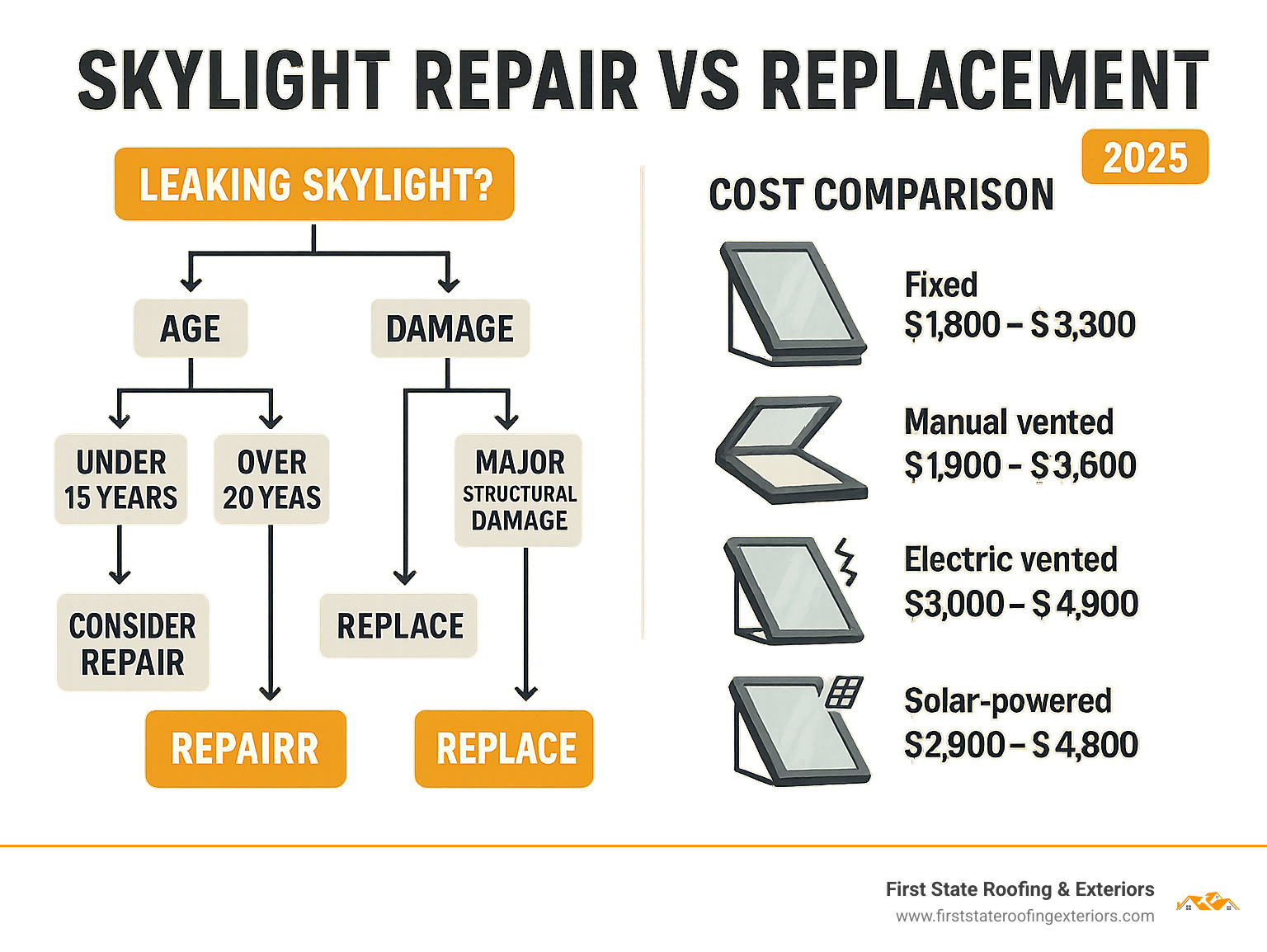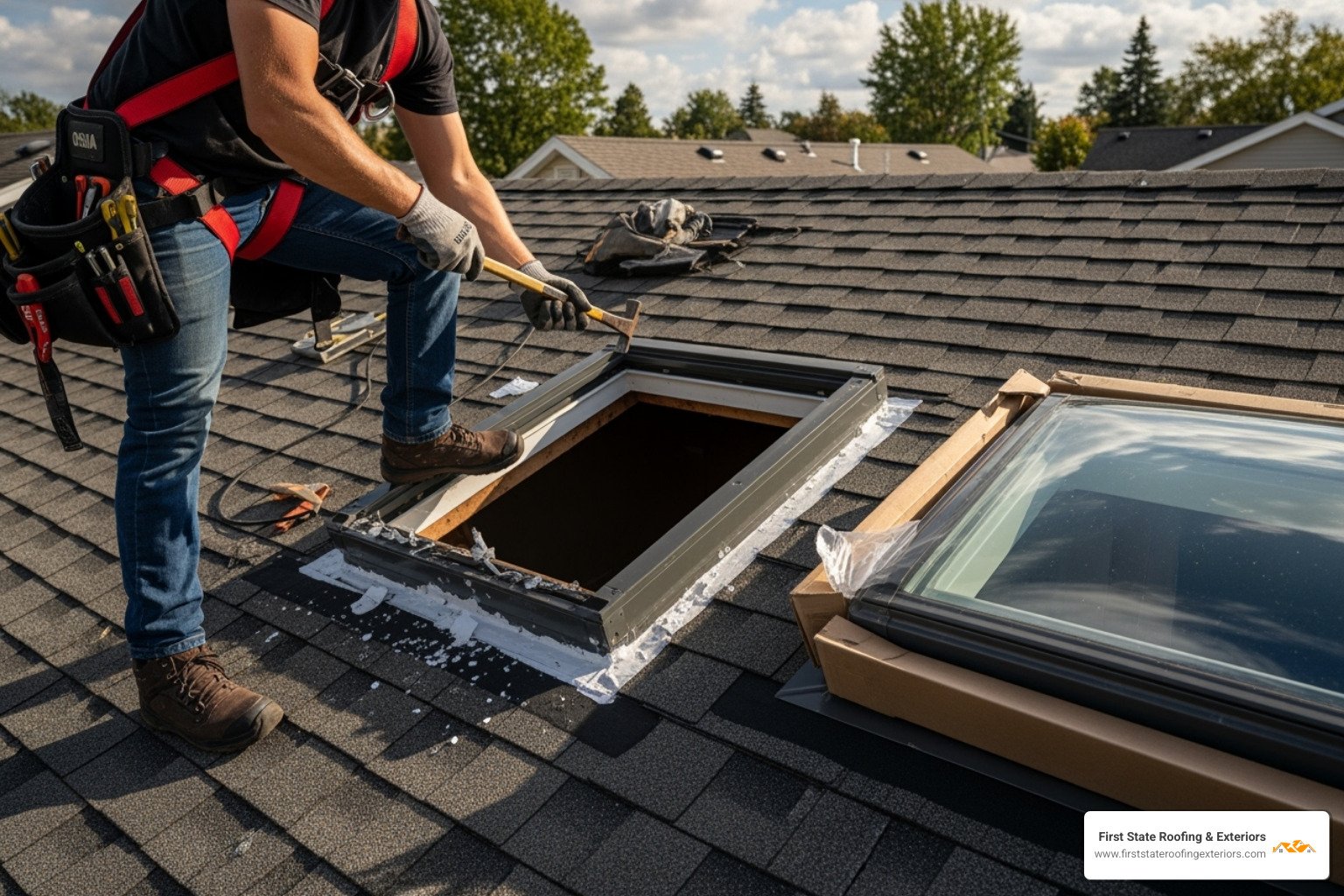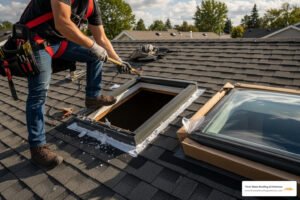Understanding Your Skylight Replacement Investment
A leaking skylight can quickly turn your peaceful home into a source of stress and potential water damage. When faced with drips, drafts, or visible cracks, homeowners need to understand their options and the costs involved. The skylight replacement cost typically ranges from $800 to $5,000, but as Delaware’s trusted roofing and exterior experts, we know several key factors determine the final price. This guide will break down the costs depending on the type, size, and complexity of your project.
Quick Cost Overview:
- Fixed skylight replacement: $1,800 – $3,300
- Manual vented skylight: $1,900 – $3,600
- Electric vented skylight: $3,000 – $4,900
- Solar-powered skylight: $2,900 – $4,800
- Labor costs: $300 – $2,500
- Additional costs: Permits ($100-$500), flashing repair ($150-$500)
The decision between repair and replacement isn’t always straightforward. Minor issues like broken seals might cost just a few hundred dollars to fix, while a complete replacement could run several thousand. However, older skylights over 15-20 years often benefit more from replacement than repeated repairs.
I’m Richard McCain, owner of First State Roofing & Exteriors, and over my 20+ years in the roofing industry, I’ve helped countless Delaware homeowners steer skylight replacement cost decisions. My experience has shown that while the initial investment may seem significant, choosing the right solution saves money and prevents headaches down the road.

Key skylight replacement cost vocabulary:
When to Repair vs. When to Replace Your Skylight
Deciding whether to repair or replace your skylight can feel like a riddle wrapped in a mystery, especially when you’re dealing with a sudden drip onto your favorite rug! But don’t worry, we’re here to help you decipher the signs. It’s all about assessing the skylight’s age, the type and severity of damage, and your long-term goals for your home’s energy efficiency and aesthetics.

A skylight’s lifespan, much like a roof’s, is typically between 15 to 25 years. However, various factors can shorten or extend this. When we talk about signs of damage, we’re looking beyond just leaks. Are you noticing condensation between the glass panes? This often indicates a seal failure, which can lead to significant energy loss and potential mold growth. Is the frame corroding or showing signs of rot? This is a serious structural issue that compromises the integrity of the skylight and your roof.
Beyond immediate problems, consider your energy efficiency goals. An older, single-pane skylight might be perfectly intact but could be a major source of heat loss in winter and heat gain in summer. Upgrading to a more modern, energy-efficient model could save you money on utility bills in the long run. Finally, think about upgrading features. Do you wish your skylight opened for ventilation, or that it had integrated blinds for light control? These desires might push you towards replacement rather than just a repair.
For more information on when to consider a larger project, you can explore our roof replacement services.
Signs Pointing to Repair
Sometimes, a little TLC is all your skylight needs. Minor issues are usually good candidates for repair, saving you money and extending the life of your existing unit.
We often recommend repair if you’re experiencing:
- Minor leaks: A small, occasional drip might be due to a failing sealant or weatherstripping rather than a major structural flaw. Resealing around the perimeter can often solve this.
- Seal failure: If you see condensation or fogging between the glass panes, the seal has likely failed. While this can be repaired, it’s a more complex fix than a simple reseal and might indicate the unit is nearing the end of its life.
- Faulty crank mechanism: For manual vented skylights, a broken hand crank or a stiff mechanism can often be replaced for a relatively low cost, typically $50-$400 for parts and labor.
- Newer unit (under 15 years): If your skylight is relatively young, say under 15 years old, and the glass and frame are largely intact, a repair is usually the most sensible and cost-effective solution. Minor skylight repairs generally cost a couple of hundred dollars, such as resealing a broken seal.
Signs Pointing to Replacement
There comes a time when even the most beloved skylight needs to retire. If your skylight is constantly giving you headaches, or if the issues are severe, replacement is often the more economical and practical choice in the long run.
Consider a full replacement if you’re facing:
- Major or persistent leaks: If you’re battling chronic leaks, especially after heavy rain or snow, it often points to issues with the flashing, frame, or overall installation. These can lead to significant water damage, potentially costing $5,000 or more if left unchecked.
- Cracked or broken glass: While glass can be replaced (typically $300-$1,500), if the skylight is older, it might be a sign that the entire unit is brittle and prone to further issues. DIY glass repairs are dangerous and not recommended.
- Frame damage or rot: Exposure to the elements can cause skylight frames to corrode or rot. A cracked or deteriorating frame not only looks bad but can also let in unconditioned air and water, compromising your home’s insulation and leading to mold.
- Condensation between glass panes: While this can be repaired, it often signals that the unit’s thermal performance is severely compromised. If the skylight is old, a new, energy-efficient model will provide much better insulation.
- Skylight is over 15-20 years old: Skylights, like roofs, have a lifespan. Most modern skylights are designed to last 15-25 years. If yours is approaching or past this age and experiencing frequent issues, a full replacement is often a wiser decision to save money on ongoing repairs and improve energy efficiency.
- Desire for a more energy-efficient model: Older skylights, particularly single-pane versions, are not as energy-efficient as today’s models. If you’re looking to reduce your energy bills and improve your home’s comfort, upgrading to a new, energy-efficient unit is a smart move.
A Detailed Breakdown of Skylight Replacement Cost
When we talk about skylight replacement cost, we’re looking at a range that can vary quite a bit, generally from $2,000 up to $5,000. This isn’t just the price tag of the new skylight; it includes materials, labor, and other essential components that ensure a watertight and long-lasting installation.
The overall cost is influenced by several factors, including the type of skylight you choose, its size, the complexity of the installation, and any additional features you opt for. Labor costs typically make up a significant portion of the total, often 40% to 60% of the project’s price, reflecting the specialized skills required for proper installation. Don’t forget about debris disposal, which is usually factored into the overall estimate, ensuring that your old skylight and any construction waste are removed properly. Flashing and sealing are critical components, as they ensure your new skylight is perfectly integrated with your roof, preventing future leaks.
Material Costs by Skylight Type
The type of skylight you select will significantly impact the material cost. Each type offers different functionalities and aesthetics, leading to varying price points.
- Fixed skylight costs: These are sealed units that don’t open, designed solely to bring natural light into a space. They are the most economical option. A fixed skylight replacement can cost around $1,800-$3,300, including the product and estimated labor. For instance, a VELUX 22-1/2 in. x 46-1/2 in. Fixed Curb-Mount Skylight with Tempered Low-E3 Glass might be around $259.00 for the unit itself.
- Manual vented skylight costs: These skylights can be opened manually, usually with a hand crank or a rod, to allow fresh air in. This added functionality comes with a slightly higher price tag. You can expect a manual vented skylight replacement to cost around $1,900-$3,600.
- Electric vented skylight costs: For ultimate convenience, electric vented skylights open and close with the touch of a button, often via a remote control. They require an electrical connection, which can add to installation complexity and cost. An electric vented skylight replacement can cost around $3,000-$4,900.
- Solar-powered skylight costs: These are similar to electric vented models but use solar energy for operation, making them energy-independent and often eligible for tax credits. A solar-powered skylight replacement can cost around $2,900-$4,800. A high-end VELUX solar-powered venting skylight with a shade could be between $1,768.00 and $2,458.00 for the product alone.
- Tubular skylight costs: Also known as sun tunnels, these are a more budget-friendly way to bring natural light into smaller, interior spaces. They channel light through a reflective tube. Tubular skylights typically cost $200-$500 for materials, with new installation ranging from $1,000-$2,500.
Labor Costs and What They Include
Labor is a substantial part of the skylight replacement cost, and for good reason. It’s not just about swapping one unit for another; it’s a skilled job that ensures your home remains watertight and beautiful.
- Typical hourly rates: Skylight replacement professionals typically charge between $30 and $80 per hour. However, for specialized roofing experts, especially those dealing with complex roof types, minimum call-out fees or higher hourly rates (e.g., $150-$300) might apply to fit a roof around a new skylight.
- Removal of old unit: The process begins with carefully removing the existing skylight and any damaged surrounding roofing materials. This includes disconnecting any electrical components for vented models.
- Installation of new unit: This involves precise placement of the new skylight, ensuring it’s level and properly seated in the roof opening.
- Flashing and weatherproofing: This is arguably the most critical part of the installation. New flashing kits (which alone can cost around $115.00 for VELUX models) are installed to create a watertight seal between the skylight and the roof. This process prevents leaks and protects your home from the elements.
- Interior finishing work: After the exterior work is complete, interior finishing such as drywall repair, painting, and trim work is often necessary to seamlessly integrate the new skylight into your home’s ceiling. This ensures a polished, professional look.
Replacing a skylight typically takes 3 to 5 hours on average, but this can extend for larger or more complex installations, especially if interior finishing is extensive.
Key Factors That Influence the Final Price
Just like baking a cake, the final skylight replacement cost isn’t just about the main ingredients; it’s about the recipe’s complexity, the size of the cake, and any fancy decorations you add! We find that several key factors significantly influence the overall price.

Installation Complexity and Your Roof’s Structure
The “personality” of your roof plays a huge role in how much skylight replacement will cost.
- Roof pitch: Steeper roofs mean more challenging and time-consuming work for our team. The slope or pitch of a roof can increase skylight installation costs by up to 20% for very steep pitches due to the added safety measures and labor difficulty.
- Roof material: The type of roofing material you have can also affect the cost. Asphalt shingles are generally easier to work with. However, metal or tile roofs can increase installation costs by up to 30% due to the need for specialized tools, techniques, and extra flashing requirements to ensure a watertight seal.
- Accessibility and height: Is your skylight easily accessible, or does it require extensive scaffolding or specialized equipment to reach? Difficult-to-access skylights, or those on multi-story homes, can increase labor costs by up to 30%.
- Custom flashing: While standard flashing kits are usually included, some unique roof configurations or older skylight designs might require custom flashing, which adds to the material and labor cost. Curb preparation and flashing work alone can be around $500 per average-sized skylight.
- Structural modifications: If you’re changing the size or location of your skylight significantly, or if the existing roof trusses need to be cut or altered, structural changes might be necessary. This can add substantial costs, including an engineer’s consultation ($300-$500) and additional framing work.
The Impact of Skylight Size on Your Skylight Replacement Cost
Size definitely matters when it comes to skylight replacement cost. It affects both the material price and the complexity of the installation.
- Standard vs. custom sizes: Opting for standard skylight sizes from manufacturers like VELUX is generally more affordable. Custom-sized skylights, while offering perfect fit and aesthetics, will naturally come with a higher price tag.
- Same-size replacement: Replacing a skylight with a unit of the exact same size is typically the most straightforward and least expensive option. The existing opening and framing are already there, which simplifies the process for our crew. A replacement is often cheaper than a brand-new installation because the opening already exists.
- Different-size replacement: If you decide to go bigger or smaller, the costs will increase. Upgrading to a larger skylight, for example, requires additional construction labor to enlarge the roof opening and potentially reinforce the framing. This involves cutting existing roofing, framing new sections, and ensuring structural integrity.
- Structural framing changes: Any alteration to the roof’s framing to accommodate a different size skylight will add to the labor time and material costs.
It’s worth noting that the U.S. Department of Energy recommends limiting skylight size to 5% of a room’s total square footage if it has many windows, and not more than 15% for rooms with few windows, to manage heat gain and maintain energy efficiency. You can find more information on their recommendations here: U.S. Department of Energy recommendations on skylight sizing.
Upgrades, Glazing, and Accessories
This is where you can truly customize your skylight, but each added feature will contribute to the total skylight replacement cost.

- Blinds and shades: Integrated blinds or shades offer privacy and light control. Manual options are less expensive, while motorized or solar-powered versions add convenience and cost. Replacing blinds for a skylight can cost $100-$250 for manual and $300-$500 for motorized (material only).
- Smart home controls: For electric or solar-powered skylights, opting for smart home integration allows you to control your skylight via apps or voice commands. This adds a layer of modern convenience but also to the price. Optional features like remote-controlled ventilation or built-in blinds can add $200-$400.
- Glazing options: The type of glass (glazing) significantly impacts performance and cost.
- Low-E coating: Low-emissivity coatings help regulate indoor temperatures by reflecting heat, making them highly energy-efficient. Additional coatings like low-E or tints can add 15-35% to the price of a replacement skylight.
- Laminated glass: This type of glass offers improved safety, as it holds together when shattered, similar to a car windshield. It also provides better sound insulation.
- Impact-resistant glass: Designed for areas prone to hail or heavy debris, this glazing can withstand significant impact, offering superior durability but at a higher cost.
- Double-pane vs. Triple-pane: Double-pane glass can increase the skylight purchase price by 50-100% over single-pane but offers 20-30% more energy efficiency. Triple-pane is even more expensive but provides superior insulation.
Don’t Forget These Additional Costs
While the skylight unit and labor are the big-ticket items, there are often other costs lurking that can add to your overall skylight replacement cost. Ignoring these can lead to unpleasant surprises!
Permits and Inspections
We always ensure all necessary permits are obtained before starting any major work on your home. This might seem like an extra step, but it’s crucial for safety and compliance.
- Building permit costs: Most skylight replacements, especially those involving structural changes or new installations, will require a building permit from your local municipality. Permit costs can vary widely but typically range from $100 to $500 or more.
- Local Delaware requirements: As local experts, we are familiar with the specific permitting requirements across Delaware, whether you’re in Milford, Dover, or Seaford. These requirements ensure that the work meets local building codes and safety standards.
- Final inspection fees: After the work is completed, a final inspection by the local building department is usually required to ensure everything was done correctly and safely. These fees are often included in the initial permit cost.
Interior Finishing and Potential Repairs
A skylight replacement isn’t just an exterior job; it often has implications for your home’s interior.
- Drywall repair: If the skylight opening needs to be adjusted in size, or if there was any water damage from a previous leak, drywall repair will likely be necessary.
- Painting and trim: Once the drywall is repaired, painting and trim work will be needed to match the surrounding ceiling and walls, ensuring a seamless finish.
- Repairing water damage: If your old skylight was leaking, there might be existing water damage to the ceiling, insulation, or even framing that needs to be addressed before the new skylight is installed. Leaking skylights can lead to significant water damage costing $5,000 or more if left unchecked. This is why addressing leaks promptly is essential.
For any interior finishing needs or complex repairs, our team can either handle it directly or recommend trusted partners. If you’re in the Seaford area, our local roofing experts in Seaford, DE are ready to assist with your project.
Frequently Asked Questions about Skylight Replacement
We get a lot of questions about skylights, and we’re always happy to provide clear answers. Here are some of the most common inquiries we receive about skylight replacement cost and related topics.
How long does a new skylight last?
A properly installed, high-quality skylight typically lasts between 15 and 25 years. We’ve seen some last as long as 40 years, while others might only last 8-15 years if not properly maintained or if they’re a lower-quality product. The lifespan depends on several factors: the material it’s made from, the quality of the installation, and the local climate conditions it endures. Regular maintenance, like clearing debris and checking seals, can help maximize its longevity. Most companies recommend replacing units after 30 years to align with new building codes and advancements in skylight technology.
Should I replace my skylight when I get a new roof?
Absolutely, yes! We wholeheartedly recommend replacing your skylight when you’re getting a new roof. This is, without a doubt, the most cost-effective time to do it. Here’s why:
- Reduced labor costs: Our roofing team is already on-site, set up, and working on your roof. The labor costs for integrating a new skylight are significantly lower than bringing a separate crew out just for the skylight later.
- Seamless integration: Replacing the skylight during a re-roof ensures the new skylight and its flashing are perfectly integrated with your new roofing system. This provides a superior, leak-proof seal right from the start, minimizing the risk of future leaks.
- Warranty preservation: Reusing an old skylight with a new roof can actually void the warranty on your new roofing system around the skylight opening. A new skylight ensures everything is covered under a fresh warranty.
- Energy efficiency upgrade: It’s an ideal opportunity to upgrade to a more energy-efficient model, saving you money on utility bills for years to come.
Can a new skylight increase my home’s value?
Yes, absolutely! A new skylight can significantly boost your home’s value. It’s not just a window in your roof; it’s an improvement to your living space.
- Increased natural light: Skylights dramatically increase natural light, making rooms feel larger, brighter, and more inviting. This is a huge selling point for potential buyers.
- Improved ventilation: Vented skylights improve airflow, which is great for managing indoor air quality and temperature.
- Improved aesthetics: Modern skylights offer sleek designs that complement contemporary home aesthetics.
- Energy efficiency: New, energy-efficient models (especially those with Low-E coatings or multi-pane glazing) can lower utility bills, which is an attractive feature for potential buyers looking for long-term savings. The total added value depends on your skylight’s size, quality, and location.
Get a Clear Estimate for Your Delaware Home
Deciding between skylight repair and replacement involves weighing the initial cost against long-term performance and peace of mind. While a simple repair might seem cheaper now, especially for minor issues, a full replacement is often the smarter investment for older, failing units that are prone to recurring problems. Proactive replacement can save you from costly water damage, higher energy bills, and the headache of constant repairs down the line. It’s an investment in your home’s comfort, energy efficiency, and overall value.
For an expert assessment, trust the local professionals at First State Roofing & Exteriors. As a company that gives free estimates, we’re committed to integrity and transparency, providing you with all the information you need to make the best decision for your home. Call us today at (302) 222-4065 for a free inspection or to learn more about our roof replacement solutions.




